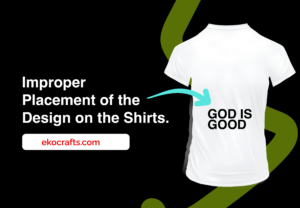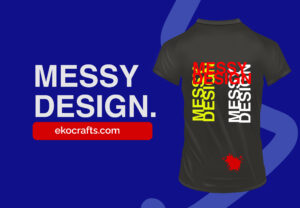I am sitting in my office thinking about the common mistakes in t-shirt printing. Making mistakes during t-shirt printing is not done only by beginners; everyone can make mistakes. Although mistakes are bound to happen, we must pay attention to our project from the start of the design to the packaging to avoid making continuous mistakes. This is because making mistakes continuously affects our credibility.
One of the common questions I hear from artists who print t-shirts for personal and commercial use is what the common mistakes in t-shirt printing are. I did some research, and these mistakes are improper placement of the design on the shirts, spelling errors, wrong choice of font and color, low-quality design, wrong choice of fabric, inappropriate size of the design, staining the dress with ink, and messy designs.
EIGHT COMMON MISTAKES WE MAKE IN T-SHIRT PRINTING.
1. Improper Placement of the Design on the Shirt.
The t-shirt printing is incomplete when the design is not adequately positioned on the shirts. Positioning designs on shirts right enables readers to read right and understand the concept. We often position the design close to the neck or the edge of the t-shirt at the bottom. The t-shirt design should be positioned about a palm length from the neck, ensuring that both sides of the design have equal dimensions. Do not place the design too close to the edge. Keep a reasonable space between the design and the edge of the dress.

2. Spelling or Grammatical Errors.
We sometimes ignore cross-checking our words to see if they are spelled correctly. Wrongly spelled words do not speak well of your brand and may lead to customers not patronizing your work.
Many websites help in cross-checking spellings or words, some of these websites are Grammarly. It helps users identify common mistakes in sentences and correct them accordingly.

3. Wrong Choice of Font and Color.
Simple designs can convey meaning better than complicated designs that are sometimes difficult to deduce meaning from. Always make sure that you choose the right font size, font color, and then right font family in your typography. The font size and color should be able to “pop out” on the printed t-shirt. Choosing the color of the font that is the same as the fabric color may undermine the ability to read the text.

4. Low-Quality Design.
Images used on t-shirts should be of higher quality. Using a pixelated image will not make the design details “pop out” which will affect the quality of the design. Always ensure that designs used for t-shirt printing are saved in CMYK format instead of RGB. The quality should have to be the highest.

5. Wrong Choice of Fabric
In t-shirt printing, one major material that you should not compromise on its quality is the fabric type. Every design best fits on its equivalent material. Choosing the right fabric is best for achieving the right design. Also, the choice of fabric to be used is dependent on the preference of the client or customers.
Here is a list of fabrics and their capability when it comes to t-shirt printing.
Cotton Fabrics:
Direct to Garment (DTG), direct-to-film (DTF), and heat press printing work best on cotton dresses. The cotton can absorb the inks easily and more faster making the design bond well with the dress. This ensures its durability over a longer period. The cotton fabric also has breathable and durable quality making it the number one choice for most people. It is capable of absorbing inks when dyed.
Polyester Fabrics:
Polyester fabrics are noted for their super durable ability, but it is not able to withstand too much heat. Dye sublimation, DTF works best with polyester fabrics.
6. Inappropriate Size of Design.
Designs printed on t-shirts should be proportional to the size of the garment. When the size of the garment is big such as extra large or extra large, a large size design which is a preference of the client should be the size of an A3 artboard. Do not use too small a design on a big t-shirt if that is not what the client ordered.

7. Staining the Dress with Ink
This is mostly common with beginners who start heat press printing. Staining t-shirts should not be encouraged under any circumstances unless otherwise it is part of the design process. Staining t-shirts inappropriately affects the quality of the design and reduces your credibility.
To avoid staining your work, you need to ensure that all materials and tools used for printing are properly cleaned and positioned at the right places on the printing desk. Use a dump cloth to clean any ink that sticks to your hands.
After printing, use turpentine or kerosene to clean the tools. This removes the excess paint and prepares them for your next project.

8. Having a Messy Design.
Good designs are those that can convey the right meaning to their audience. Always keep your designs as simple as possible. This will help you to convey the right message to your audience. Creating tiny designs that are complex may not be the ideal way to put your message across. Good designs should be visible when scaled up or down.

